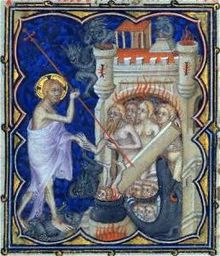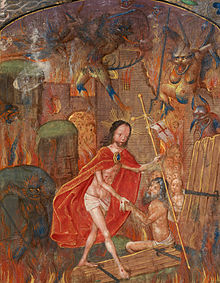
Back نزول المسيح إلى الجحيم Arabic Съшествие в ада Bulgarian Descens de Crist als inferns Catalan Abstieg Christi in die Unterwelt German Κάθοδος του Χριστού στον Άδη Greek Descenso de Cristo a los infiernos Spanish Alla läinud surmavalda Estonian Jesus infernuetara jaistea Basque Descente aux Enfers (Jésus) French Turunnya Kristus ke neraka ID



| Events in the |
| Life of Jesus according to the canonical gospels |
|---|
 |
|
Portals: |
In Christian theology, the Harrowing of Hell (Latin: Descensus Christi ad Inferos, "the descent of Christ into Hell" or Hades)[a] is the period of time between the Crucifixion of Jesus and his resurrection. In triumphant descent, Christ brought salvation to the souls held captive there since the beginning of the world.[1]
Christ's descent into the world of the dead is referred to in the Apostles' Creed and the Athanasian Creed (Quicumque vult), which state that he "descended into the underworld" (descendit ad inferos), although neither mention that he liberated the dead. His descent to the underworld is alluded to in the New Testament in 1 Peter 4:6, which states that the "good tidings were proclaimed to the dead".[2] The Catechism of the Catholic Church notes Ephesians 4:9, which states that "[Christ] descended into the lower parts of the earth", as also supporting this interpretation.[3] These passages in the New Testament have given rise to differing interpretations.[4] The Harrowing of Hell is commemorated in the liturgical calendar on Holy Saturday.[5]
According to The Catholic Encyclopedia, the story first appears clearly in the Gospel of Nicodemus in the section called the Acts of Pilate, which also appears separately at earlier dates within the Acts of Peter and Paul.[6] The descent into Hell had been related in Old English poems connected with the names of Cædmon (e.g. Christ and Satan) and Cynewulf. It is subsequently repeated in Ælfric of Eynsham's homilies c. 1000 AD, which is the first known inclusion of the word "harrowing". Middle English dramatic literature contains the fullest and most dramatic development of the subject.[1]
As a subject in Christian art, it is also known as the Anastasis (Greek for "resurrection"), considered a creation of Byzantine culture and first appearing in the West in the early 8th century.[7]
Cite error: There are <ref group=lower-alpha> tags or {{efn}} templates on this page, but the references will not show without a {{reflist|group=lower-alpha}} template or {{notelist}} template (see the help page).
- ^ a b "CATHOLIC ENCYCLOPEDIA: Harrowing of Hell". www.newadvent.org. Vol. 7. Archived from the original on May 11, 2023. Retrieved May 11, 2023.
- ^ Hart, David Bentley, ed. (January 2017). The New Testament: a translation. New Haven: Yale University Press. ISBN 978-0-300-18609-3. OCLC 1002687102.
- ^ "631", Catechism, archived from the original on April 10, 2020, retrieved March 15, 2020.
- ^ D. Bruce Lockerbie (1977). The Apostle's Creed: Do You Really Believe It. Wheaton, Illinois: Victor Books, pp. 53–54. Archived July 9, 2012, at archive.today.
- ^ Keene, Michael (1995). The Christian Experience. Nelson Thornes. p. 112. ISBN 978-0-7487-2188-7. Archived from the original on May 29, 2024. Retrieved March 14, 2018.
- ^ Wilhelm Schneemelcher, R. McLachlan Wilson (December 1, 1990) New Testament Apocrypha, Vol. 1 ISBN 0-66422721-X pp. 501–02
- ^ Ross, Leslie (1996). Medieval art : a topical dictionary. Internet Archive. Westport, Connecticut, United States: Greenwood Press. pp. 10–11. ISBN 978-0-313-29329-0.